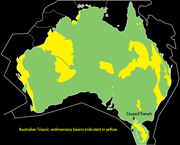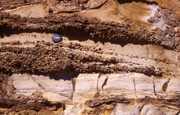Locality Bacchus Marsh Council Trench
The Triassic flora of the Council Trench Formation, Victoria, Australia
The fossil flora of the Council Trench Formation contains at least 20 species of sphenophytes, liverworts, ferns, pteridosperms, cycadophytes, ginkgoaleans and conifers that likely derive from a mix of swamp and elevated sub-environments of an alluvial plain experiencing a cool, humid climate (Webb & Mitchell 2006). The NRM collections contains a very small assemblage (only two specimens) of fossil plants from the Council Trench Formation collected by N.O. Holst in 1897.
Reference
Douglas, J.G., 1969. The Mesozoic floras of Victoria. Parts 1 and 2. Memoirs of the Geological Survey of Victoria 28, 1-310.
Douglas, J.G., 1973. The Mesozoic floras of Victoria. Part 3. Memoirs of the Geological Sur-vey of Victoria 29, 1-185.
Duddy, I. R., 2003. Chapter 9 - Mesozoic. In Geology of Victoria, W.D. Birch, ed., Geological Society of Australia Special Publication 23, 239-286.
McCoy, F., 1892. Report on palaeontology of the Geological Survey for the year 1891. Annual Report, Secretary of Mines, Victoria for 1891 (1892), 30.
McCoy, F., 1894. in Officer, G. & Balfour, L., Further notes on the glacial deposits of Bacchus Marsh. Proceedings of the Royal Society of Victoria, new series 6, 139-143.
McCoy, F., 1898. Note on an additional genus of fossil plants found in the Bacchus Marsh sandstone. Proceedings of the Royal Society of Victoria, new series 10, 285-286.
Robertson, W.P., 1934. Local Freestone. Bacchus Marsh Express 6th October 1934.
Webb, J.A. & Mitchell, M.M., 2006. Stratigraphy and palaeoflora of the Triassic Council Trench Formation, central Victoria. Proceedings of the Royal Society of Victoria 118, 113-127.




